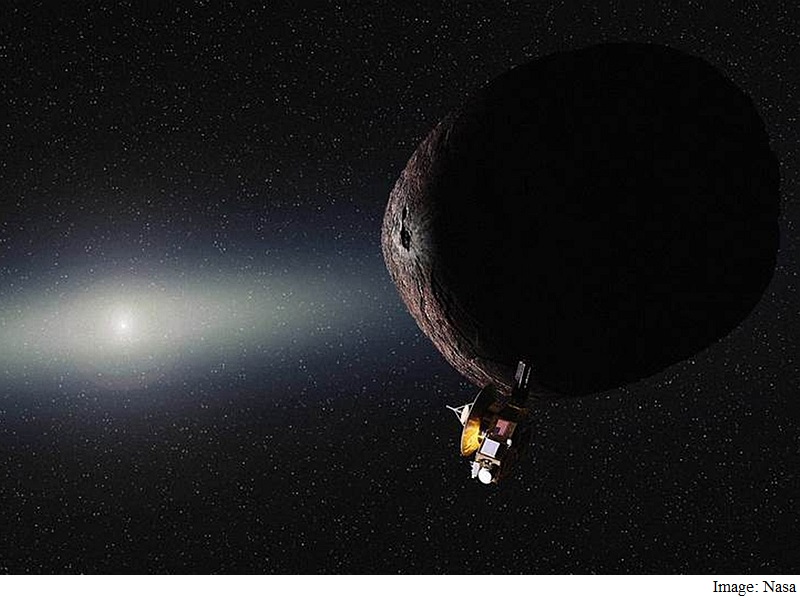- Home
- Science
- Science News
- Nasa Selects Next Flyby Target for New Horizons Probe
Nasa Selects Next Flyby Target for New Horizons Probe

After its historic July 14 flyby of the Pluto system that revealed interesting findings, Nasa has selected the next potential next destination for its New Horizons mission - a small Kuiper Belt object (KBO) known as 2014 MU69 that orbits nearly a billion miles beyond Pluto.
This remote KBO was one of two identified as potential destinations and the one recommended to Nasa by the New Horizons team.
"Even as New Horizon speeds away from Pluto out into the Kuiper Belt, we are looking outward to the next destination for this intrepid explorer," said John Grunsfeld, chief of the Nasa Science Mission Directorate at the agency headquarters in Washington, DC.
New Horizons will perform a series of four maneuvers in late October and early November to set its course toward 2014 MU69 - nicknamed "PT1" (Potential Target 1) - which it expects to reach on January 1, 2019.
Any delays from those dates would cost precious fuel and add mission risk.
Although Nasa has selected 2014 MU69 as the target, as part of its normal review process the agency will conduct a detailed assessment before officially approving the mission extension to conduct additional science.
"2014 MU69 is a great choice because it is just the kind of ancient KBO, formed where it orbits now, that the Decadal Survey desired us to fly by," said New Horizons principal investigator Alan Stern.
New Horizons was originally designed to fly beyond the Pluto system and explore additional Kuiper Belt objects.
The spacecraft carries extra hydrazine fuel for a KBO flyby and its communications system is designed to work from far beyond Pluto.
"Its power system is designed to operate for many more years and its scientific instruments were designed to operate in light levels much lower than it will experience during the 2014 MU69 flyby," the US space agency said in a statement.
Unlike asteroids, KBOs have been heated only slightly by the Sun, and are thought to represent a well preserved, deep-freeze sample of what the outer solar system was like following its birth 4.6 billion years ago.
Catch the latest from the Consumer Electronics Show on Gadgets 360, at our CES 2026 hub.
- Samsung Galaxy Unpacked 2025
- ChatGPT
- Redmi Note 14 Pro+
- iPhone 16
- Apple Vision Pro
- Oneplus 12
- OnePlus Nord CE 3 Lite 5G
- iPhone 13
- Xiaomi 14 Pro
- Oppo Find N3
- Tecno Spark Go (2023)
- Realme V30
- Best Phones Under 25000
- Samsung Galaxy S24 Series
- Cryptocurrency
- iQoo 12
- Samsung Galaxy S24 Ultra
- Giottus
- Samsung Galaxy Z Flip 5
- Apple 'Scary Fast'
- Housefull 5
- GoPro Hero 12 Black Review
- Invincible Season 2
- JioGlass
- HD Ready TV
- Laptop Under 50000
- Smartwatch Under 10000
- Latest Mobile Phones
- Compare Phones
- Vivo Y500i
- OnePlus Turbo 6V
- OnePlus Turbo 6
- Itel Zeno 20 Max
- OPPO Reno 15 Pro Mini 5G
- Poco M8 Pro 5G
- Motorola Signature
- Vivo Y50e 5G
- Lenovo Yoga Slim 7x (2025)
- Lenovo Yoga Slim 7a
- Realme Pad 3
- OPPO Pad Air 5
- Xiaomi Watch 5
- Huawei Watch 10th Anniversary Edition
- Acerpure Nitro Z Series 100-inch QLED TV
- Samsung 43 Inch LED Ultra HD (4K) Smart TV (UA43UE81AFULXL)
- Asus ROG Ally
- Nintendo Switch Lite
- Haier 1.6 Ton 5 Star Inverter Split AC (HSU19G-MZAID5BN-INV)
- Haier 1.6 Ton 5 Star Inverter Split AC (HSU19G-MZAIM5BN-INV)












